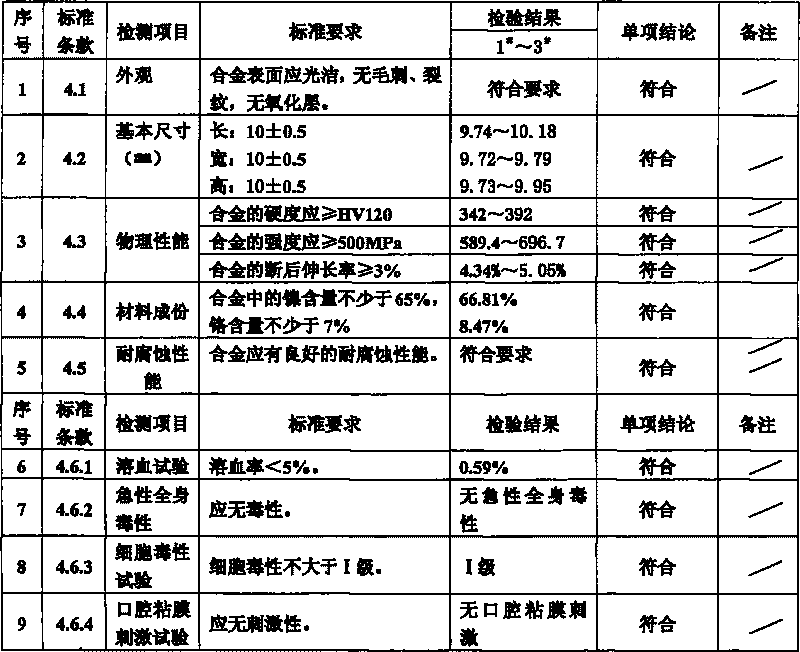Soft steel alloy material for dentistry
An alloy material, mild steel technology, used in dentistry, medical science, dental preparations, etc., can solve problems such as competition, and achieve good wear resistance, good corrosion resistance, and good biocompatibility.
- Summary
- Abstract
- Description
- Claims
- Application Information
AI Technical Summary
Problems solved by technology
Method used
Image
Examples
Embodiment 1
[0009] Nickel (Ni) 66.4%, Chromium (Cr) 8.3%, Copper (Cu) 5.8%, Tin (Sn) 5%, Molybdenum (Mo) 4.3%, Titanium (Ti) 3.3%, Silicon (Si) 2.8%, Iron (Fe) 1.9%, manganese (Mn) 1.1%, and carbon (C) 1.1%. The safety and physical properties of the dental mild steel alloy material obtained after vacuum melting and vacuum casting in this embodiment are shown in Table 1, and the safety refers to the biological test results.
Embodiment 2
[0011] Nickel (Ni) 69%, Chromium (Cr) 9.5%, Copper (Cu) 5%, Tin (Sn) 4%, Molybdenum (Mo) 4%, Titanium (Ti) 3%, Silicon (Si) 2%, Iron (Fe) 1.5%, manganese (Mn) 1.0%, and carbon (C) 1.0%. The safety and physical properties of the dental mild steel alloy material obtained after vacuum melting and vacuum casting in this embodiment are shown in Table 1, and the safety refers to the biological test results.
Embodiment 3
[0013] Nickel (Ni) 67.7%, Chromium (Cr) 9%, Copper (Cu) 5.5%, Tin (Sn) 4.5%, Molybdenum (Mo) 3.8%, Titanium (Ti) 3%, Silicon (Si) 2.5%, Iron (Fe) 1.7%, manganese (Mn) 1.2%, and carbon (C) 1.1%. The safety and physical properties of the dental mild steel alloy material obtained after vacuum melting and vacuum casting in this embodiment are shown in Table 1, and the safety refers to the biological test results.
[0014] Table 1 shows the test results of dental mild steel made from the dental mild steel alloy materials obtained in Examples 1-3 of the present invention.
[0015]
[0016] The standard clauses in the above table refer to the standard YZB / Su 0572-2009 for medical device registration products in Jiangsu Province, China; 1 in the above table # ~3 # Refers to the sampling sample of the mild steel for dental use obtained after vacuum melting and vacuum casting of the mild steel alloy material for dental use obtained in Examples 1-3. The material composition is repo...
PUM
| Property | Measurement | Unit |
|---|---|---|
| tensile strength | aaaaa | aaaaa |
| Vickers hardness | aaaaa | aaaaa |
| elongation | aaaaa | aaaaa |
Abstract
Description
Claims
Application Information
 Login to View More
Login to View More - R&D
- Intellectual Property
- Life Sciences
- Materials
- Tech Scout
- Unparalleled Data Quality
- Higher Quality Content
- 60% Fewer Hallucinations
Browse by: Latest US Patents, China's latest patents, Technical Efficacy Thesaurus, Application Domain, Technology Topic, Popular Technical Reports.
© 2025 PatSnap. All rights reserved.Legal|Privacy policy|Modern Slavery Act Transparency Statement|Sitemap|About US| Contact US: help@patsnap.com


